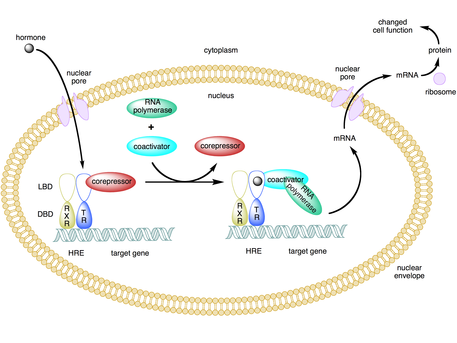Coactivator (genetics)

A coactivator is a type of transcriptional coregulator that binds to an activator (a transcription factor) to increase the rate of transcription of a gene or set of genes.[1] The activator contains a DNA binding domain that binds either to a DNA promoter site or a specific DNA regulatory sequence called an enhancer.[2][3] Binding of the activator-coactivator complex increases the speed of transcription by recruiting general transcription machinery to the promoter, therefore increasing gene expression.[3][4][5] The use of activators and coactivators allows for highly specific expression of certain genes depending on cell type and developmental stage.[2]
Some coactivators also have histone acetyltransferase (HAT) activity. HATs form large multiprotein complexes that weaken the association of histones to DNA by acetylating the N-terminal histone tail. This provides more space for the transcription machinery to bind to the promoter, therefore increasing gene expression.[1][4]
Activators are found in all living organisms, but coactivator proteins are typically only found in eukaryotes because they are more complex and require a more intricate mechanism for gene regulation.[1][4] In eukaryotes, coactivators are usually proteins that are localized in the nucleus.[1][6]
Mechanism

Some coactivators indirectly regulate gene expression by binding to an activator and inducing a conformational change that then allows the activator to bind to the DNA enhancer or promoter sequence.[2][7][8] Once the activator-coactivator complex binds to the enhancer, RNA polymerase II and other general transcription machinery are recruited to the DNA and transcription begins.[9]
Histone acetyltransferase
Nuclear DNA is normally wrapped tightly around histones, making it hard or impossible for the transcription machinery to access the DNA. This association is due primarily to the electrostatic attraction between the DNA and histones as the DNA phosphate backbone is negatively charged and histones are rich in lysine residues, which are positively charged.[10] The tight DNA-histone association prevents the transcription of DNA into RNA.
Many coactivators have histone acetyltransferase (HAT) activity meaning that they can acetylate specific lysine residues on the N-terminal tails of histones.[4][7][11] In this method, an activator binds to an enhancer site and recruits a HAT complex that then acetylates nucleosomal promoter-bound histones by neutralizing the positively charged lysine residues.[7][11] This charge neutralization causes the histones to have a weaker bond to the negatively charged DNA, which relaxes the chromatin structure, allowing other transcription factors or transcription machinery to bind to the promoter (transcription initiation).[4][11] Acetylation by HAT complexes may also help keep chromatin open throughout the process of elongation, increasing the speed of transcription.[4]

Acetylation of the N-terminal histone tail is one of the most common protein modifications found in eukaryotes, with about 85% of all human proteins being acetylated.[12] Acetylation is crucial for synthesis, stability, function, regulation and localization of proteins and RNA transcripts.[11][12]
HATs function similarly to N-terminal acetyltransferases (NATs) but their acetylation is reversible unlike in NATs.[13] HAT mediated histone acetylation is reversed using histone deacetylase (HDAC), which catalyzes the hydrolysis of lysine residues, removing the acetyl group from the histones.[4][7][11] This causes the chromatin to close back up from their relaxed state, making it difficult for the transcription machinery to bind to the promoter, thus repressing gene expression.[4][7]
Examples of coactivators that display HAT activity include CARM1, CBP and EP300.[14][15]
Corepression
Many coactivators also function as corepressors under certain circumstances.[5][9] Cofactors such as TAF1 and BTAF1 can initiate transcription in the presence of an activator (act as a coactivator) and repress basal transcription in the absence of an activator (act as a corepressor).[9]
Significance
Biological significance
Transcriptional regulation is one of the most common ways for an organism to alter gene expression.[16] The use of activation and coactivation allows for greater control over when, where and how much of a protein is produced.[1][7][16] This enables each cell to be able to quickly respond to environmental or physiological changes and helps to mitigate any damage that may occur if it were otherwise unregulated.[1][7]
Associated disorders
As drug targets
Coactivators are promising targets for drug therapies in the treatment of cancer,
Because transcription factors control many different biological processes, they are ideal targets for drug therapy.[14][21] The coactivators that regulate them can be easily replaced with a synthetic ligand that allows for control over an increase or decrease in gene expression.[14]
Further technological advances will provide new insights into the function and regulation of coactivators at a whole-organism level and elucidate their role in human disease, which will hopefully provide better targets for future drug therapies.[14][15]
Known coactivators
To date there are more than 300 known coregulators.[15] Some examples of these coactivators include:[22]
- ARA54 targets androgen receptors
- ATXN7L3 targets several members of the nuclear receptor superfamily
- BCL3 targets 9-cis retinoic acid receptor (RXR)
- CBP targets many transcription factors
- CDC25B targets steroid receptors
- COPS5 targets several nuclear receptors
- DDC targets androgen receptors
- EP300 targets many transcription factors
- KAT5 targets many nuclear receptors
- KDM1A targets androgen receptors
- Steroid receptor coactivator (SRC) family
- YAP targets transcription factors
- WWTR1 targets transcription factors
See also
References
- ^ OCLC 173367793.
- ^ a b c "General transcription factor / transcription factor". Learn Science at Scitable. Retrieved 2017-11-29.
- ^ PMID 23503198.
- ^ PMID 10637607.
- ^ OCLC 261137374.
- PMID 28724529.
- ^ S2CID 14668705.
- PMID 27175900.
- ^ S2CID 13073440.
- ISSN 0036-8075.
- ^ S2CID 38649132.
- ^ PMID 21750686.
- PMID 22405572.
- ^ PMID 22733267.
- ^ PMID 20933027.
- ^ a b "Enhancer". Learn Science at Scitable. Retrieved 2017-11-29.
- OCLC 41266312.
- .
- ^ "Nuclear Receptors". courses.washington.edu. Retrieved 2017-11-29.
- PMID 22924430.
- S2CID 16891519.
- ^ "NURSA - Molecules". nursa.org. Retrieved 2017-11-30.
External links
- Nuclear Receptor Signalling Atlas (NIH-funded research consortium and database; includes open-access PubMed-indexed journal, Nuclear Receptor Signaling)
- TcoF - Dragon database of transcription co-factors and transcription factor interacting proteins
